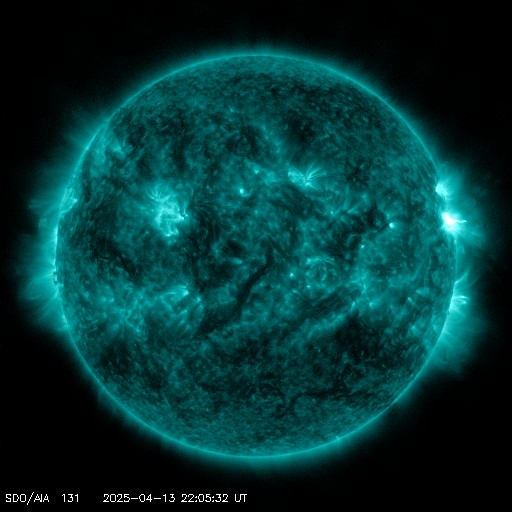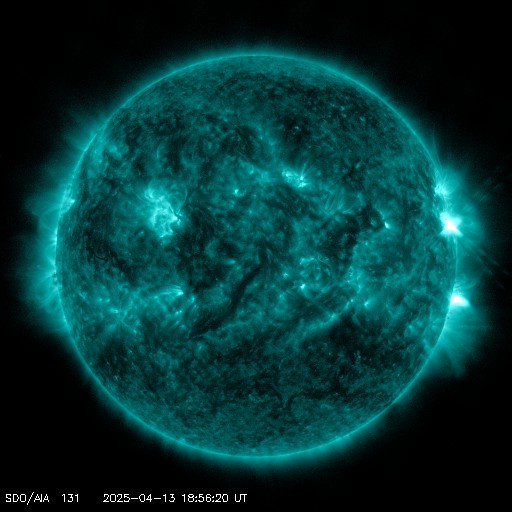Viewing archive of Sunday, 4 October 2015
Daily bulletin on solar and geomagnetic activity from the SIDC
Issued: 2015 Oct 04 1234 UTC
SIDC Forecast
Solar flares
C-class flares expected, (probability >=50%)
Geomagnetism
Minor storm expected (A>=30 or K=5)
Solar protons
Warning condition (activity levels expected to increase, but no numeric forecast given)
| 10cm flux | Ap | |
|---|---|---|
| 04 Oct 2015 | 090 | 016 |
| 05 Oct 2015 | 080 | 017 |
| 06 Oct 2015 | 080 | 007 |
Bulletin
During the past period, there were only three active regions on the solar disk. Four lower C-class flares and one M1.0 (peaking at 2:41 UT on October 4) flare were observed. The M1 flare originated from NOAA 2422, though being almost completely behind the West limb. NOAA 2427 now is a beta-gamma region, though it did not produce any significant flares the past 24 hours. Flaring activity at the C-level is expected. An extended equatorial positive polarity coronal hole has reached the central meridian and will be geo-effective within about 3 days.
Solar wind observations show a slight increase in speed (up to 500 km/s) and temperature from 15 UT October 4 on. The interplanetary magnetic field magnitude was maximally around 10 nT, with a mainly negative Bz component. Solar wind is expected to remain slightly disturbed and possibly indicate the arrival of a glancing blow related to the September 30 CME later today. Geomagnetic conditions were unsettled at the local level (Dourbes K=3) and active (NOAA Kp=4 at 3-6 UT) to even minor storm (NOAA Kp=5 at 9 UT) levels at the planetary level. Geomagnetic activity could be at to active or minor storm conditions during the next 24 hours.
Today's estimated international sunspot number (ISN): 021, based on 10 stations.Solar indices for 03 Oct 2015
| Wolf number Catania | /// |
| 10cm solar flux | 097 |
| AK Chambon La Forêt | 020 |
| AK Wingst | 008 |
| Estimated Ap | 009 |
| Estimated international sunspot number | 046 - Based on 12 stations |
Noticeable events summary
| Day | Begin | Max | End | Loc | Strength | OP | 10cm | Catania/NOAA | Radio burst types |
|---|---|---|---|---|---|---|---|---|---|
| 04 | 0234 | 0241 | 0248 | ---- | M1.0 | --/2422 |
Provided by the Solar Influences Data analysis Center© - SIDC - Processed by SpaceWeatherLive
All times in UTC
Current data suggests there is a slight possibility for aurora to appear at the following high latitude regions in the near future
Iqaluit, NUNuuk
Reykjavik
Latest news
Latest forum messages
Support SpaceWeatherLive.com!
A lot of people come to SpaceWeatherLive to follow the Sun's activity or if there is aurora to be seen, but with more traffic comes higher server costs. Consider a donation if you enjoy SpaceWeatherLive so we can keep the website online!

Latest alerts
Sunday, 13 April 2025
22:21 UTC - Solar flare
Moderate M1.66 flare from sunspot region 4055
22:03 UTC - Radio Blackout
Minor R1 radio blackout in progress (≥M1 - current: M1.01)
20:48 UTC - Hemispheric Power Index
The OVATION model predicts the Hemispheric Power Index to reach 50GW at 21:39 UTC
19:09 UTC - Solar flare
Moderate M3.24 flare from sunspot region 4055
18:51 UTC - Radio Blackout
Minor R1 radio blackout in progress (≥M1 - current: M1.07)
Space weather facts
| Last X-flare | 2025/03/28 | X1.1 |
| Last M-flare | 2025/04/13 | M1.6 |
| Last geomagnetic storm | 2025/04/06 | Kp5 (G1) |
| Spotless days | |
|---|---|
| Last spotless day | 2022/06/08 |
| Monthly mean Sunspot Number | |
|---|---|
| March 2025 | 134.2 -20.4 |
| April 2025 | 136.4 +2.2 |
| Last 30 days | 134.2 -8.9 |




